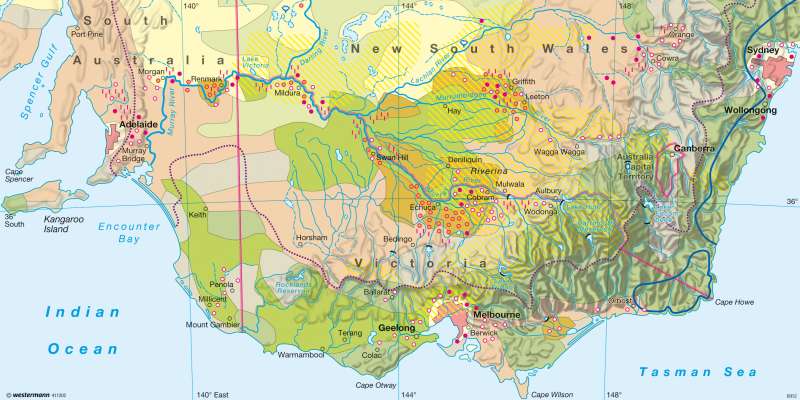Murray-Darling Basin (Australia) — Agricultural and climate variability
The world - Environment
978-3-14-100790-9 | Page 198 | Ill. 2

Information
The Murray and Murrumbidgee rivers form the only river system in Australia that carries water permanently. In its upper reaches the Murray is characterized by narrow gorges and steep gradients, but already near Albury (160 m) it enters an alluvial plain where it meanders and wanders wildly. This is the heartland of irrigation-based cultivation, supported by tributaries from the pastoral regions of the Victorian Highlands.Regulation of the Volume of Flow
In the past, the natural fluctuations in the volume of flow of the Murray system were the main obstacle to a more intensive cultivation of this region. Disastrous floods in some years contrasted with extremely dry periods during which the river hardly managed to reach its mouth. This applied in even more extreme form to its longest tributary, the Darling, which only carries water at certain seasons and therefore cannot be used for irrigation. To achieve real improvements a combination of various measures was required.
Among the most crucial tasks was to diminish the danger of flooding by damming the river and constructing storage reservoirs such as Lake Victoria and Lake Hume, and ensuring a constant flow of water by incorporating all the water reserves into a comprehensive water utilization system (Lake Dartmouth, Lake Eildon, Snowy Mountains). Further important challenges were to develop a large-scale irrigation system with local reservoirs, and to guarantee the supply of drinking water to the population centres around Melbourne and Adelaide.
Cultivated Crops and Irrigation Economy
The first attempts at irrigation-based agriculture date from 1887, when the first citrus plantations were laid out around Mildura and Renmark. These attempts quickly failed due to the insecurity of the water supply and especially to soil salinization. Immigration into these districts from Southern Europe after 1945 led to the spread of citrus and wine growing, mainly in conjunction with sheep farming. Today the southern states of South Australia, New South Wales and Victoria are the centre of the Australian wine industry, which has developed into an important sector of the economy thanks to enormous growth rates, especially since the later 1990s. Australian wine production now holds a top position internationally in terms of both quality and quantity.
In the Riverina region in the south of New South Wales, which is crossed by numerous old river beds, the cultivation of cotton has increased in recent years, and especially wheat and to a lesser extent specialized crops are also grown here. To its south is the centre of Australian citrus fruit production, using irrigation-based cultivation. Around the urban centres of Melbourne and Adelaide, the growing of fruit and vegetables predominates.
The principal irrigation methods involve the flooding of pasture land. Sprinkling is mainly used for fodder crops and vegetables, and furrow irrigation for wine, cotton and fruit. The lack of drainage has caused a rise in the level of the groundwater to within one or two metres below the surface. The resulting increase in water levels due to capillary action has led to the salinization of the uppermost soil layers. In New South Wales and Victoria, 240,000 hectares of land are already salinated and 8.7 million hectares are under severe threat. In the Murray's lower reaches the washed-out salts have caused a sharp rise in salinity, increasingly threatening the drinking water supply to Adelaide. In dry years the WHO standard for drinking water is no longer reached in this region.
W. Maresch; Ü: J. Attfield




